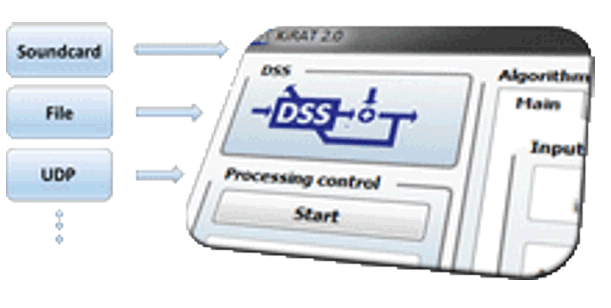Application Examples
Sonar Signal Processing |
 |
||
| Contents: | ||
The video shows the application of KiRAT for a SONAR application, in particular for a realtime detecion of divers and ships. At the beginning an omnidirectional processing mode was activated and the correlation of the beamformer outputs was performed with the unprocessed send signals. Afterwards send beamforming was activated to show the increment of energy in a certain direction. Finally, the correlation was performed with a multitude of temporally spreaded send signals in order to account different hypothesis in terms of radial speed (Doppler). In that case the individual results are depicted in a variety of parallel plots.
Medical Signal Processing |
The video shows the application of KiRAT for a medical application, in particular for electro- and magnetoneurography. The main objective of this modern technologies (electro- and also magnetoneurography) is to optimize the diagnostic accuracy of neuropathies by developing a spatially continuous scanning of nerves with sensor arrays. This approach will increase and also combine the spatial resolution and functional information. In summary, this will further improve the treatment. The electrical signal and also the nerve electromagnetic field of human nerve pulses are quite low. Peak amplitudes in the range of uV to mV and fT to pT can be achieved by using an external electric stimulation of the nerve. As the stimulus to the nerve can be repeated, the Signal-to-Noise-Ratio can be further improved by using enhanced low-noise adaptive averaging algorithms. This video presents a typical application of such averaging algorithms for electro- and magnetoneurography in real-time.
Parkinson Speech Recording |
The video shows the application of KiRAT for Parkinson speech recordings. The main objective is to make speech recordings of Parkinson patients with different and freely designed test setups for later analysis of the Parkinson speech. This setup uses an extra window for the patient view, which shows simple instructions for the patient, to guide them through the recording session. The medical view is shown in the main window of KiRAT, which allows for more detailed adjustments of the tests. For example, tests can be enabled or disabled, a progressbar for the recording session is shown and a real-time plotter gives the possibility to observe the microphone signal while recording them. The test setup is freely designable via html pages. Thus, this functionality can easily be used for creating any kind of speech database.
In-car Communication (ICC) System and the Plotter |
The video shows the application of KiRAT for in-car communication (ICC) and the capabilities of its plotter. ICC is an highly complex task with many algorithms, which depend on various parameters. After installing such a system in a car it needs to be adapted for the car's conditions. We call this tuning. However, a value change of parameters can cause a different or unexpected behavior. Therefore, the plotter is a very useful tool for monitoring. Signals and parameters can be watched in the time and the frequency domain. There is also an opportunity to plot spectrograms. For complex algorithms many signals and parameters must be watched in parallel. For this the plotter offers an free arrangeable window, in which as many plotters as needed can be added during the run time.
Real-time Heart Rate Variablity (HRV) Analysis |
The video shows the application of KiRAT for cardiologic applications. The heart beat of a person is measured either based on electrical (ECG) or magenetic sensors (MCG). After a detection of the so-called R peak in each heart beat several statistical analyses are performed. Both, the analysis as well as the update of the results, is performed in real-time. The video above shows the HRV cardio graphical user interface of KiRAT.
Real-time Underwater Channel Simulation |
The video shows the application of KiRAT for SONAR applications. Several send and receive hydrophones can be placed in an underwater environement with adjustment possibilities, such as sound velocity profiles (depth dependent). In addition, wind speed and direction can be adjusted (both is fed into a statical model for creating a time and location dependent water surface and corresponding noise). Furthermore, several moving target can be simulated. The channel simulation is based on a restricted 3D ray tracing scheme, that allows freqeuency dependant ray parameters (e.g. reflection and attenuation).

 On behalf of the members of the Chair of Digital Signal Processing and System Theory, we would like to take this opportunity to wish you all a very Merry Christmas and a peaceful, restful winter break. We hope that this festive season brings you joy, relaxation, and cherished moments with your loved ones.
On behalf of the members of the Chair of Digital Signal Processing and System Theory, we would like to take this opportunity to wish you all a very Merry Christmas and a peaceful, restful winter break. We hope that this festive season brings you joy, relaxation, and cherished moments with your loved ones.